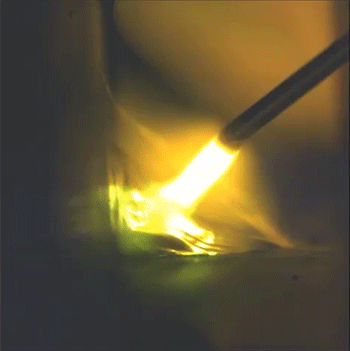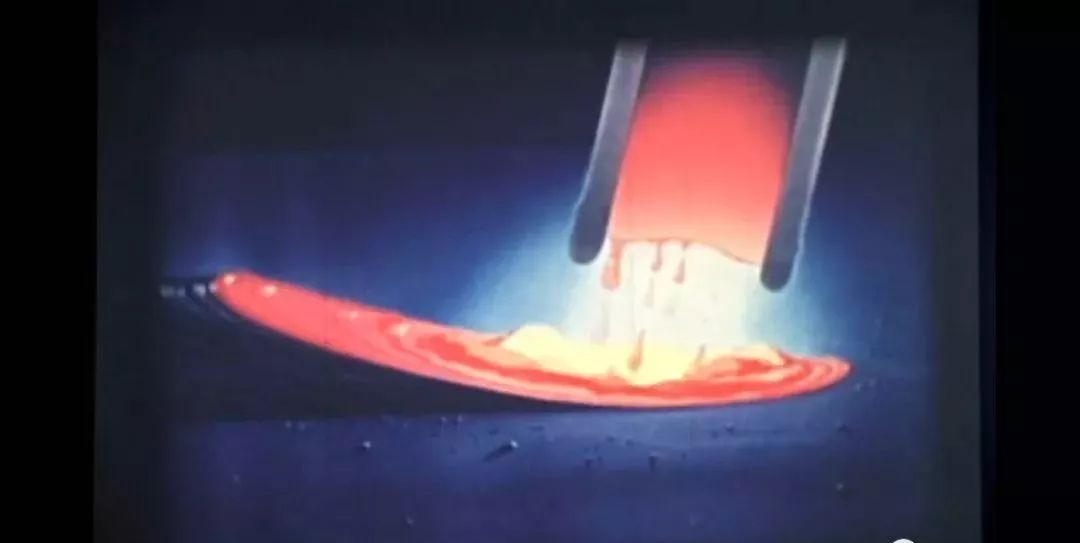01 Gravity of molten drop
Any object will have a tendency to sag due to its own gravity. In flat welding, the gravity of the metal molten droplet promotes the transition of the molten droplet. However, in vertical welding and overhead welding, the gravity of the molten droplet hinders the transition of the molten droplet to the molten pool and becomes an obstacle.
02 Surface tension
Like other liquids, liquid metal has surface tension, that is, when there is no external force, the surface area of the liquid will be minimized and shrunk into a circle. For liquid metal, the surface tension makes the molten metal spherical.
After the electrode metal melts, its liquid metal does not fall off immediately, but forms a spherical droplet hanging at the end of the electrode under the action of surface tension. As the electrode continues to melt, the volume of the molten droplet continues to increase until the force acting on the molten droplet exceeds the tension between the interface of the molten droplet and the welding core, and the molten droplet will break away from the welding core and transition to the molten pool. Therefore, surface tension is not conducive to the transition of molten droplets in flat welding.
However, surface tension is beneficial to the transfer of molten droplets when welding in other positions such as overhead welding. First, the molten pool metal hangs upside down on the weld under the action of surface tension and is not easy to drip;
Second, when the molten droplet at the end of the electrode contacts the molten pool metal, the molten droplet will be pulled into the molten pool due to the action of the surface tension of the molten pool.
The greater the surface tension, the larger the molten droplet at the end of the welding core. The size of the surface tension is related to many factors. For example, the larger the diameter of the electrode, the greater the surface tension of the molten droplet at the end of the electrode;
The higher the temperature of the liquid metal, the smaller its surface tension. Adding oxidizing gas (Ar-O2 Ar-CO2) to the shielding gas can significantly reduce the surface tension of the liquid metal, which is conducive to the formation of fine particle molten droplets to transfer to the molten pool.
03 Electromagnetic force (electromagnetic contraction force)
Opposites attract, so the two conductors attract each other. The force that attracts the two conductors is called electromagnetic force. The direction is from outside to inside. The magnitude of the electromagnetic force is proportional to the product of the currents of the two conductors, that is, the greater the current passing through the conductor, the greater the electromagnetic force.
When welding, we can regard the charged welding wire and the liquid droplet at the end of the welding wire as composed of many current-carrying conductors.
In this way, according to the above-mentioned electromagnetic effect principle, it is not difficult to understand that the welding wire and the droplet are also subject to radial contraction forces from all sides to the center, so it is called electromagnetic compression force.
The electromagnetic compression force makes the cross-section of the welding rod tend to shrink. The electromagnetic compression force has no effect on the solid part of the welding rod, but it has a great influence on the liquid metal at the end of the welding rod, prompting the droplet to form quickly.
On the spherical metal droplet, the electromagnetic force acts vertically on its surface. The place with the largest current density will be the thin diameter part of the droplet, which will also be the place where the electromagnetic compression force acts the most.
Therefore, as the neck gradually becomes thinner, the current density increases, and the electromagnetic compression force also increases, which prompts the molten droplet to quickly break away from the end of the electrode and transition to the molten pool. This ensures that the molten droplet can smoothly transition to melting at any spatial position.

Xinfa welding equipment has the characteristics of high quality and low price. For details, please visit: Welding & Cutting Manufacturers - China Welding & Cutting Factory & Suppliers (xinfatools.com)
In the two cases of low welding current and welding, the influence of electromagnetic compression force on droplet transition is different. When the welding current is low, the electromagnetic force is small. At this time, the liquid metal at the end of the welding wire is mainly affected by two forces, one is surface tension and the other is gravity.
Therefore, as the welding wire continues to melt, the volume of the liquid droplet hanging at the end of the welding wire continues to increase. When the volume increases to a certain extent and its gravity is sufficient to overcome the surface tension, the droplet will break away from the welding wire and fall into the molten pool under the action of gravity.
In this case, the size of the droplet is often large. When such a large droplet passes through the arc gap, the arc is often short-circuited, resulting in large splashes, and the arc burning is very unstable. When the welding current is large, the electromagnetic compression force is relatively large.
In contrast, the role of gravity is very small. The liquid droplet mainly transitions to the molten pool with smaller droplets under the action of electromagnetic compression force, and the directionality is strong. Regardless of the flat welding position or the overhead welding position, the droplet metal always transitions from the welding wire to the molten pool along the arc axis under the action of magnetic field compression force.
During welding, the current density on the electrode or wire is generally relatively large, so the electromagnetic force is a major force that promotes the transition of the molten droplet during welding. When the gas shield rod is used, the size of the molten droplet is controlled by adjusting the density of the welding current, which is a major means of technology.
Welding is the electromagnetic force around the arc. In addition to the above-mentioned effects, it can also produce another force, which is the force generated by the uneven distribution of the magnetic field intensity.
Because the current density of the electrode metal is greater than the density of the weldment, the magnetic field intensity generated on the electrode is greater than the magnetic field intensity generated on the weldment, so a field force is generated along the longitudinal direction of the electrode.
Its direction of action is from the place with high magnetic field intensity (electrode) to the place with low magnetic field intensity (weldment), so no matter what the spatial position of the weld is, it is always conducive to the transition of the molten droplet to the molten pool.

04 Pole pressure (spot force)
The charged particles in the welding arc are mainly electrons and positive ions. Due to the action of the electric field, the electron line moves toward the anode and the positive ions move toward the cathode. These charged particles collide with the bright spots at the two poles and are generated.
When the DC is positively connected, the pressure of the positive ions hinders the transition of the molten droplet. When the DC is reversely connected, it is the pressure of the electrons that hinders the transition of the molten droplet. Since the mass of positive ions is greater than that of electrons, the pressure of the positive ion flow is greater than that of the electron flow.
Therefore, it is easy to produce fine particle transition when the reverse connection is connected, but it is not easy when the positive connection is connected. This is because of the different pole pressures.
05 Gas blowing force (plasma flow force)
In manual arc welding, the melting of the electrode coating lags slightly behind the melting of the welding core, forming a small section of "trumpet"-shaped sleeve that has not yet melted at the end of the coating.
There is a large amount of gas generated by the decomposition of the coating gasifier and CO gas generated by the oxidation of carbon elements in the welding core in the casing. These gases expand rapidly due to being heated to high temperature, and rush along the direction of the unmelted casing in a straight (straight) and stable airflow, blowing the molten droplets into the molten pool. Regardless of the spatial position of the weld, this airflow will be beneficial to the transition of the molten metal.
Post time: Aug-20-2024



